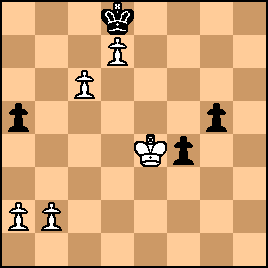Jun-30-04
 | | Chessical: Messrs. Fiske,Fuller and Perrin teach Morphy not to overestimate his attacking chances using the Two Knights Defence. Morphy had faith in this line as Black using it aginst De Riviere later, but he abandoned the Qh4 idea for a f5 pawn thrust, e.g. <12.Nc3> f5 13.Be3 Bb4 14.Qd2 Bd7 15.g3 Qe7 agianst De Riviere, London 1859; and <12.Nd2> f5 13.Nb3 Bd6 14.0-0 Bxh2+ 15.Kxh2 f4 16.Qxe4 Ng5 against De Riviere, Paris 1863. On this basis instead of <13...Qh4>, an improvement would have been <13...f5> e.g. 14.c5 Bxh2+ 15.Kxh2 Qxd5 16.Rd1 |
|
Jun-30-04
 | | tpstar: <Chessical> 1) Why not 22 ... Bxc2 instead (23. Qxc2 Qxh4)? 2) Why not 44. c6 a6 45. b4 and Black's in zugzwang? Thank you. |
|
| Jul-01-04 | | chessfected: 22...Bxc2 23.g4 Qg5 24. Nf3 Qg6 25. c5 followed by 26. Ne5 with triple attack on f7, not to mention the Bishop on c2.
You're right about the Zugzwang. But I guess exchanging rooks does the job as well. |
|
Jul-01-04
 | | beatgiant: <1) Why not 22 ... Bxc2 instead (23. Qxc2 Qxh4)?> Maybe White would play 23. g4 Qg5 24. Qxf7ch. Your other suggestion, <2) Why not 44. c6 a6 45. b4 and Black's in zugzwang> looks right. But the line in the game is also an easy win. |
|
Jul-01-04
 | | Chessical: <Tpstar> The lines given by <Chessfected> and <Beatgiant> are convincing. Morphy's position was sufficiently lost for there to be more than one route to victory. I believe that Morphy saw that <22 ... Bxc2> was too dangerous, and that the consultants played <44.Rxd8> as a certain win. |
|
| Jul-22-06 | | Rocafella: It takes 3 people to beat Morphy. Shows how good he was ;) |
|
Dec-30-18
 | | MissScarlett: When this game appeared in Fiske's <Chess Monthly> of May 1858, p.144, it included the misstep <46.Kd5 Ke7 47.Ke4 Kd8>, so the game ran 51 moves. |
|
Aug-03-21
 | | fredthebear: From the original annotations:
On Sunday, December 6, Morphy visited Eugene Cook in Hoboken, New Jersey, accompanied by Fredrick Perrin, W. J. A. Fuller and D. W. Fiske. While there, the three visitors played a consultation game against Morphy, which they won. Cook, a brilliant problemist, was an invalid confined to his house most of the time. When the First American Chess Congress was published, the frontispeice was a chess problem composed by Cook and "Dedicated with the Highest Esteem and Admiration to Paul Morphy, the Only." -- Lawson Lawson's book on Morphy: https://www.amazon.com/Paul-Morphy-... |
|
Aug-03-21
 | | fredthebear: Some may find this history of the First American Chess Congress interesting: http://www.edochess.ca/batgirl/morp... |
|
| Feb-08-22 | | Z free or die: Did the score (movelist) come from Lawson?
I have a source where there's a repetition of position after 45...a5: 
click for larger viewso it goes 46.Kd5 Ke7 47.Ke4 Kd8 and then finishes as above. (It's in Hazeltine's scrapbooks, but is almost certainly from a London paper) |
|
| Feb-08-22 | | Z free or die: (I had a moment thinking I found a new Morphy game when I first compared the game lengths - a bit over optimistic of me) |
|
Feb-08-22
 | | MissScarlett: <(I had a moment thinking I found a new Morphy game when I first compared the game lengths - a bit over optimistic of me)> That happened to me recently, as well, but I have no excuse because the game length search turned up the original. It was the year that tripped me up. <(It's in Hazeltine's scrapbooks, but is almost certainly from a London paper)> The game appeared in the <ILN> of June 12th 1858 and <Bell's Life> of November 21st. Staunton crops off <50...axb4 51.axb4>, so yours is likely the latter. The typefaces of the papers are quite distinctive. |
|





